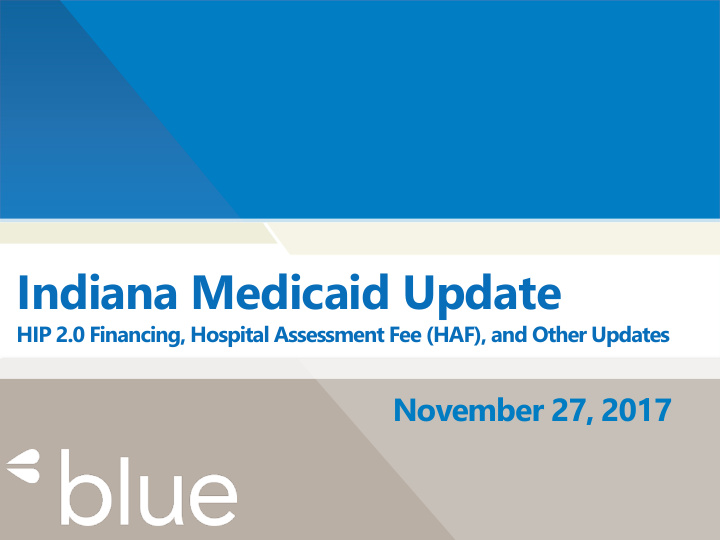



Indiana Medicaid Update HIP 2.0 Financing, Hospital Assessment Fee (HAF), and Other Updates November 27, 2017
Basics of the HAF • Legal authority for fees • Who is assessed or exempt • Basis of fee • Fee rates • History of HAF Payment Factors • Applying Payment Factors • History of Total Fees • HIP 2.0 Funding • HAF vs HIP Fees 2
Legal Authority • HAF exists in the Indiana Code as enacted by the General Assembly • The Medicaid State Plan governs the HAF factors along with DSH eligibility and payment order • Changes must be submitted by the end of the first quarter of the SFY to be effective for a SFY • There is a waiver from CMS that allows Indiana to make exceptions to fees so that they do not have to be “broad - based” and/or uniform • Changes in exemptions or fee rates require changes to the waiver and must meet statistical tests that prove the fee is not redistributive • Changes to any of the above can create long delays 3
Who is Assessed or Exempt • Facilities within the class that are assessed • Acute care hospitals • Freestanding psychiatric hospitals • Facilities exempt from the fee • Long-term care hospitals • Freestanding rehabilitation hospitals • Hospitals owned by the state or federal government • Freestanding psychiatric hospitals with greater than 40% of admissions having a primary diagnosis of chemical dependency • Freestanding psychiatric hospitals with greater with > 90% of admissions comprised of individuals 55 or older having a primary diagnosis of Alzheimer’s disease or certain neurologic disorders 4 related to trauma or aging
Basis of the Fee • Fees are based on the total patient days and outpatient charges from cost reports on file at end of Feb. for each upcoming fee year • SFYs 2018-19 were based on reports on file Feb. 2017 • This data is the basis of a hospital’s fees for a two -year period, but the amount assessed will change based on total program expenditures 5
Basis of the Fee • Fees assessed on total days (not Medicaid days) capped at 6% of net statewide inpatient revenue • Days are net of out-of-state days • “Day is a day” ; cannot be manipulated like other statistics • Outpatient fee assessed for amount over 6% of net statewide inpatient revenue • Outpatient fee based on OP-equivalent patient days • Excludes MRO and non-UB billings if properly identified on the cost report • OP portion has increased with HIP 6
“Rate” of the Fee • Three “tiers” • 100% of days (net of OOS days) • 75% of days for most acute care DSH hospitals, • 50% of days for psychiatric hospitals meeting the LIUR ( low income utilization rate) *The LIUR is determined during the Medicaid DSH Eligibility Surveys – next one early 2018 7
History of HAF Payment Factors 8
Applying Payment Factors • Fee-for-service (FFS), Hoosier Healthwise (HHW), Hoosier Care Connect (HCC) and HIP claims should be reimbursed in similar manner • Payment from Anthem, MDWise, MHS, and Caresource, should be consistent between MCEs • HAF Factors applied at the claim level Monthly lump sum checks from MCEs ended for 12/31/16 services All add-on factors applied at claims level • Laboratory services are still exempt from HAF outpatient factor – paid at fee schedule less 3% 9
History of Total Fees $597M 10 ** HIP 2.0 FeesHIP 2.0 fees
HIP 2.0 Funding • Per Term Sheet, no HAF funding used until SFY 2017 for HIP 2.0 program (started July 1, 2016). • Hospitals ’ obligation to fund these expenses ceases immediately if the waiver is terminated for any reason. 11
HAF VS HIP FEES HAF Fees Fund… HIP Fees Fund… • Difference between • Expansion population Medicaid fee schedule • Medical expenses and “Medicare” for • Limited administrative Traditional & Managed costs Care population (FFS, • Increases to physician HHW, HCC) payments to 75% of • IP , OP , Psych and Medicare Distinct Part Rehab • Medicaid DSH 12
Legislative Issues • HAF expires in state law June 30, 2019 • External threats, like legal challenges from net contributors • Possible federal limitations, such as reducing 6% limit on provider fee programs • Federal DSH reductions under ACA • Delayed until FY 2018 under H.R. 2 13
Non-HAF Funding Sources • The portion of the tobacco tax that was established for funding HIP 1.0 will represent the “ first doll ar” commitment to the program, reducing the amount needed from the HAF (this revenue is currently about $112 M per year) • In addition, the balance of the HIP Trust Fund will remain dedicated to the program, either for regular expenses or in case of a phase-out (current balance is around $338 M) • IHA will work to explore other funding sources (other provider fees, excise taxes, etc.) in the future that could supplement HAF contributions 14
Hospital Assistance Program (HAP) • Some hospitals are “net contributors” under the HAF program • Voluntary 501(c)(3) “foundation” model • Participation open to all, even non-members • Net contributors within “winner” systems not eligible • SFY 2012-16 completed • Five to seven eligible hospitals each year to-date • For 2012 through 2016, collected just under $2 M each year which was about 90% of the requested amounts 15
Thank you and Questions? Sally Cleveland, Director Michael Alessandrini, Director Blue & Co., LLC Blue & Co., LLC 317-713-7920 317-713-7959 scleveland@blueandco.com malessandrini@blueandco.com 16
Recommend
More recommend